

Mission Statement
The Kalamazoo Stormwater Working Group (KSWG) is a collaborative effort of outreach and education for our interconnected Municipal Separate Storm Sewer Systems (or MS4s) in the Kalamazoo County area. Rain falls and snow melts across hard and impervious surfaces that do not allow water to soak into the ground. The water flows to storm sewers or catch basins which direct it to a natural surface water body such as a wetland, river, pond or lake. Stormwater runoff carries salts, grass clippings, sediment, fertilizer, oils, pet waste, and other material left on driveways and sidewalks into the catch basins, and unfortunately, they eventually drain to our natural water bodies.
KSWG partners work together to protect against harmful discharges to the Kalamazoo River and its tributaries.
Select a Partner:Check below to see info!
Kalamazoo County Drain Commissioners Office
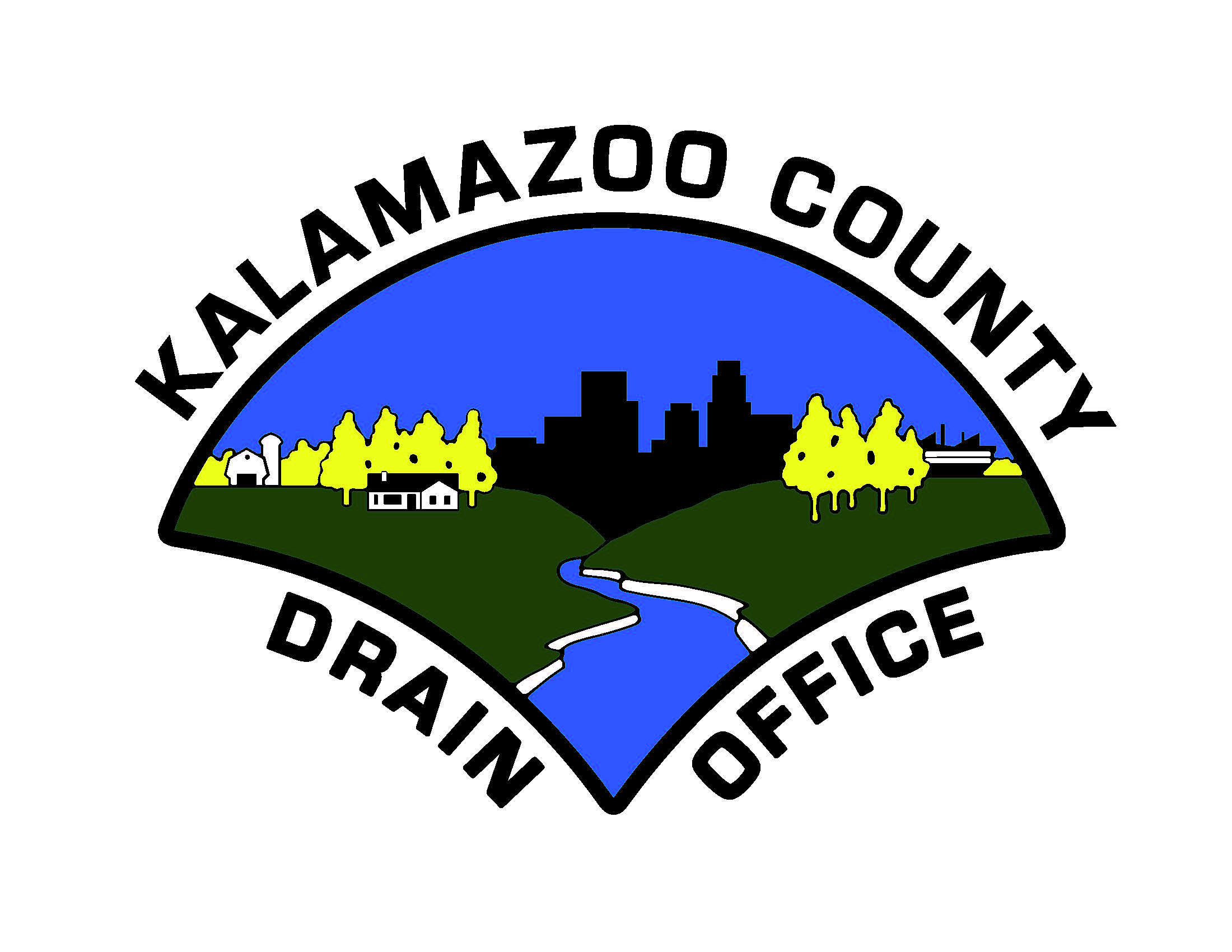
Our Mission is to provide for the health, safety and welfare of Kalamazoo County citizens, the protection of surface waters and the environment, and to promote the long-term environmental sustainability of Kalamazoo County by providing storm water management, flood control, soil erosion controls and education.
Pet Waste Composting
For owners interested in using pet waste for composting, it's no easy task. The heap has to exceed 165 degrees Fahrenheit to safely sterilize the waste, which is a difficult temperature for most backyard compost systems to reach. Even if the temperature is possible, it's still risky to use the waste as a fertilizer in gardens, as noted earlier. If you really want to compost it, investigating underground composting options similar to those used for outhouses.
Proper Disposal Practices for Grass Clippings, Leaf Litter, and Pet Waste
Learn how to Protect Your Stormwater
It is easy to do your part to protect our streams and the drainage systems leading to our waterways:
1. Do not pile leaves or other yard waste near streams or drainage channels where they can blow or wash into creeks. Use designated leaf collection bags for curbside leaf recycling
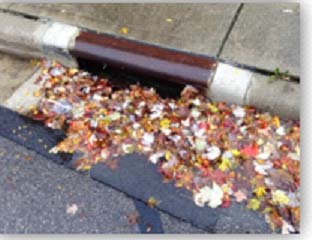
2. Do not blow leaves or grass clippings off your property into streets, streams, ponds, or drainage swales
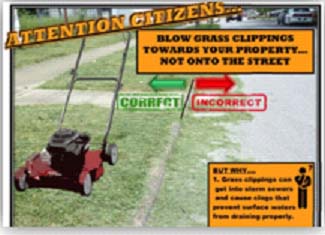
3. Recycle grass clippings and their nutrients on your lawn. Use a mulching lawnmower to recycle remaining leaves into your lawn in the fall!
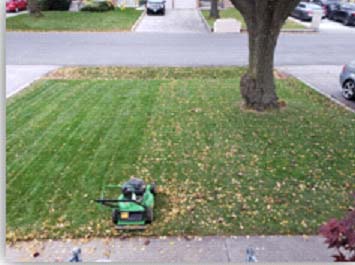
4. Compost leaves and grass clippings along with yard waste. Select a location removed from streams, ponds, and wetlands.
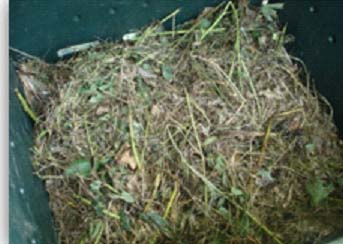
Yard Debris
Residents face this issue when faced with lawn clippings, pine straw, and other small yard debris throughout the year. Once the raking and leaf blowing is done, where should it all go? Leaf litter poses a serious hazard when it accumulates in storm drains and gutters. The storm drains are designed to allow water to quickly drain away after a heavy rainfall, but if they become blocked or clogged, serious flooding issues can occur. Leaf litter decomposes more quickly in urban gutters than it does in natural forest settings. The rapid rate of decomposition may release more nutrients into the surface water after rainfall events. It is important to prevent this, because the introduction of nutrients into the surface water is a leading cause of unsightly algae growth. While nutrients are useful in helping plants grow in your garden or lawn, too much of a good thing is actually a bad thing. Rapid influxes of nutrients from decomposing leaves and grass cause algae to proliferate in surface waters, making the water unfit for swimming and killing native plants and fish. Because this is such an important issue to citizens, most municipalities even have ordinance pertaining to it, prohibiting the introduction of yard debris into our streets and drainage system. We need to keep storm drains and gutters clear, and proper disposal of yard debris is something each of us can do. How do we do it? There are a few ways:
1.Utilize the leaf litter and grass clippings as mulch for flower beds, vegetable gardens, or along fence lines to prevent weed growth. Mulch has numerous benefits to the soil; it helps retain moisture, insulates, and protects from temperature fluctuation, and improves soil health through the addition of nutrients via decomposition. Mulch can also help protect the quality of local lakes and streams by reducing soil erosion and stormwater runoff.
2.Add the material to your compost; leaves are rich in minerals and nutrients. Grinding them with the lawnmower before adding to the compost will ensure that they release their nutrients and accelerate the composting process. Leaves add carbon and fibrous material to your compost pile, so it's best to balance their contribution with a nitrogen source. Fortunately, grass clippings are high in nitrogen, so yard debris becomes a winning combination in your compost pile!
3.Allow grass clippings or ground leaves to dry and decompose in place. They won't smother your grass; in fact, they will add nutrients and help retain soil moisture.
4.Collect and store the leaves and grass clippings in bags to be collected on yard waste pickup day. Proper disposal will keep our waters clear and help prevent flooding.
Yard clippings and fallen leaves, if not properly disposed, can accumulate in drainage systems and clog sewer pipes. Clogged pipes cause storm drain overflows leading to street or yard flooding. In addition, accumulated yard waste in drainage systems can case pollution of our waterways and increased maintenance costs with only a moderate amount of rain. Yard clippings and waste contain nutrients like phosphorus. When added to streams, ponds, and wetlands, nutrients encourage lush growth of pond weeds and algae in the spring that can reduce the amount of oxygen in the water needed to sustain fish and aquatic life. In severe cases, this accumulation of nutrients can contribute to the growth of cyanobacteria (blue green algae) blooms that can be toxic to people and animals, interfering with our ability to use these water bodies for fishing and swimming. Herbicides may also be present on yard clippings, which can cause impacts to the receiving water bodies.
Pet Waste
Pet waste that isn't properly disposed of isn't just a hazard waiting to happen to your favorite pair of shoes, and it doesn't just disappear (unless you have a friendly neighborhood pet waste disposal person).The Environmental Protection Agency (EPA) considers pet waste a "nonpoint source pollutant." This type of pollution is caused by runoff from rainfall or snowmelt moving over the ground, picking up the pollutant and depositing it into natural bodies of water and underground drinking water. When pet waste is left on the ground, it can have a devastating impact on lawns and, more importantly, on the larger environment as well. It also poses a threat to people and other animals
Human Hazards
Two of the greatest dangers of unattended pet waste are the parasites and bacteria found inside it. "Roundworm eggs last for years, and [because of this], dog waste should not go in compost that will end up as vegetable garden fertilizers. Hookworms are a concern in sandy areas where people are on the beach or barefoot in parks and playgrounds since these worms will migrate under the skin, causing scars," says Steve B. Thompson, DVM, DABVP, clinical associate professor at Purdue University's College of Veterinary Medicine and director of the Pet Wellness Clinic at Purdue. "These two worms are the primary reason for 'pooper scooper' laws at the beach and public parks,"
Other bacteria and parasites that can survive in dog and cat waste include tapeworms, Salmonella, Giardia and Escherichia coli (E. coli). Cat feces can also contain Toxoplasma gondii, which can lead to the disease toxoplasmosis.
If waste is not picked up, people and pets are at risk for being infected or reinfected with these parasites. Pets who walk through your house after being in an area with unattended waste can also increase your exposure to these dangers because they may track that waste into your home. For the same reason, children who play outside in areas frequented by dogs or cats should always wash their hands afterward, just in case they came in contact with pet feces.
Environmental Effects
Although waste that gets into the water can spread these parasites and bacteria, waste's high concentrations of nutrients such as nitrogen and phosphorus can also harm aquatic ecosystems. It can contribute to the nutrient pollution that causes algal blooms, which kill aquatic life and plants and can make people, and pets, sick.
According to the EPA, 2 to 3 days of droppings from a population of 100 dogs contribute enough bacteria, nitrogen and phosphorus to temporarily close a beach to swimming. While some people think pet waste acts as a good fertilizer because of these nutrients, leaving waste on your lawn can have the opposite effect, causing "lawn burn" and killing grass.
Removing Pet Waste, an Environmentally Friendly Way
Pet waste should be removed on a regular basis.
For those who want to be environmentally conscious, in our region, your trash goes to a landfill. Therefore, you may want to look for biodegradable pet waste bags. Removal and disposal of pet waste in biodegradable bags will have the least impact on landfills.
This month's stormwater topic is brought to you by KSWG partner

The Village with a Vision
Starting in 1830, the Village of Vicksburg has become rich with community resources and partnerships.
Topic 6. Promote Proper Disposal Practices for Grass Clippings, Leaf Litter, and Animal Waste.
This project has been funded wholly or in part by a grant through the Watershed Council Support Program by the Michigan Department of Environment, Great Lakes, and Energy's Nonpoint Source Program to Kalamazoo Stormwater Working Group for the Multilingual Outreach and Education project. The contents of the document do not necessarily reflect the views and policies of the Department of Environment, Great Lakes, and Energy, nor does the mention of trade names or commercial products constitute endorsement or recommendation for use.
Este proyecto ha sido financiado en su totalidad o en parte por una subvención a través del Programa de Apoyo del Consejo de Cuencas Hidrográficas del Departamento de Medio Ambiente, Grandes Lagos y Energía de Michigan, Programa de Fuentes No Puntuales para el Grupo de Trabajo de Aguas Pluviales de Kalamazoo para el proyecto de Educación y Alcance Multilingüe. El contenido del documento no refleja necesariamente los puntos de vista y las políticas del Departamento de Medio Ambiente, Grandes Lagos y Energía, ni la mención de nombres comerciales o productos comerciales constituye respaldo o recomendación para su uso.
Estado de la Misión
El Grupo de trabajo de aguas pluviales de Kalamazoo (KSWG) es un esfuerzo colaborativo de divulgación y educación para nuestros sistemas de alcantarillado pluvial separados municipales interconectados (o MS4) en el área del condado de Kalamazoo. La lluvia cae y la nieve se derrite sobre superficies duras e impermeables que no permiten que el agua penetre en el suelo. El agua fluye hacia las alcantarillas pluviales o sumideros que la dirigen a un cuerpo de agua superficial natural, como un humedal, un río, un estanque o un lago. La escorrentía de aguas pluviales transporta sales, recortes de césped, sedimentos, fertilizantes, aceites, desechos de mascotas y otros materiales que quedan en los caminos de entrada y las aceras hacia los sumideros y, desafortunadamente, eventualmente se drena en nuestros cuerpos de agua natural. Los socios de KSWG trabajan juntos para proteger el río Kalamazoo y sus afluentes de descargas dañinas.
KNOW THE FACTS
Tips for stormwater management on your property
DID YOU KNOW:
- Yard debris, including leaves and other organic plant material like shrubbery trimmings and grass clippings, are a significant source of stormwater pollution. This debris can clog culverts, storm drains, and pipes, causing flooding.
- Debris can carry fertilizers and pesticides from your yard and deposit them in streams and ponds.
- Piles of leaves and grass clippings will overload a stream's ability to process leaf litter, causing nutrient pollution and oxygen depletion.

It is never too late to start your own at home compost pile. NRDC has a great link to backyard composting
Keeping everyone safe
The surest way to decrease the impact of your pet's waste is by removing it promptly.
"You're doing the right thing environmentally by picking up waste in your own backyard. Help educate people in your community about the importance of this, either with waste stations or educational materials. It's not just about you and your backyard, if everyone works together, then we can all positively impact the community

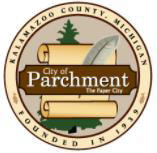
.jpg)
